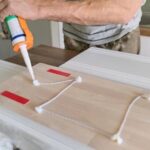Woodworking often involves using a variety of tools and techniques to create stunning, durable pieces. From saws and sanders to chisels and clamps, woodworkers are always on the lookout for new ways to improve their craft. But is a crockpot good for anything in woodworking? In this article, we’ll explore the unconventional use of a crockpot in woodworking projects, uncovering its potential benefits and practical applications.
While it may seem unusual at first, using a crockpot in woodworking can actually offer several advantages. From drying wood glue to softening old finishes, the controlled heating capabilities of a crockpot can be invaluable in certain woodworking tasks. In this article, we’ll delve into the benefits of incorporating a crockpot into your woodworking arsenal and how it can elevate your craft.
In the following sections, we will discuss how to use a crockpot for various woodworking projects, including tips for maximizing its potential and ensuring safety. Additionally, we will explore different types of wood glue and their compatibility with crockpot heating, as well as present case studies of successful woodworking projects utilizing this unconventional tool.
Whether you’re an experienced woodworker or just starting out, the versatility of a crockpot in woodworking may surprise you. So let’s dive in and discover the untapped potential of this household appliance in the world of woodworking.
Understanding the Benefits of Using a Crockpot in Woodworking
Woodworkers are constantly looking for innovative ways to improve their craft, and one surprising tool that has gained popularity in the woodworking community is the crockpot. While it may seem unconventional, a crockpot can actually be quite beneficial in woodworking projects. One of the main advantages of using a crockpot in woodworking is its ability to heat and soften wood glue, making it easier to work with certain types of adhesives.
The gentle and consistent heat provided by a crockpot is particularly useful when working with wood glue that requires activation through heat. For example, hide glue, which has been used in woodworking for centuries, typically needs to be heated before application.
By heating the glue in a crockpot, woodworkers can ensure that the adhesive reaches the proper consistency for effective bonding. Additionally, using a crockpot can also extend the open time or working time of some wood glues, allowing for more precise assembly and adjustments during the woodworking process.
In addition to its usefulness in preparing and activating wood glue, a crockpot can also serve as a makeshift tool for steaming and bending wood. Some woodworkers have successfully used a crockpot to create steam chambers for bending wooden components, such as chair rails or instrument sides.
By harnessing the steam produced by a crockpot, woodworkers can soften the fibers of the wood enough to manipulate them into curved shapes without causing damage or splintering. This technique can be particularly valuable in projects that require custom or intricate designs involving curved wood elements.
| Benefits of Using Crockpot | Examples |
|---|---|
| Heating and softening wood glue | Hide glue activation |
| Extending open time of wood glues | Precise assembly and adjustments |
| Steaming and bending wood | Creating curved wooden components |
How to Use a Crockpot for Woodworking Projects
Woodworking and crockpots may seem like an unlikely combination, but the truth is that a crockpot can be a valuable tool in woodworking projects. Whether you need to soften old wood glue, heat up wood to make it more pliable, or even use it for bending wood, a crockpot can be a versatile and handy addition to your arsenal of tools.
Softening Old Wood Glue
One of the most common uses for a crockpot in woodworking is to soften old wood glue. By placing the piece of wood with dried glue into the crockpot with some water and letting it heat up slowly, the old glue can become pliable again. This makes it easier to remove or reposition the pieces, saving time and effort compared to other methods.
Heating Wood for Bending
Another useful application of a crockpot in woodworking is heating wood for bending. Whether you are working on furniture restoration or creating curved wooden pieces, heating the wood in a crockpot can make it more flexible and easier to manipulate without risking damage from excessive heat.
Creating Custom Wood Treatments
In addition to softening old glue and heating wood for bending purposes, a crockpot can also be used to create custom wood treatments such as stains and dyes by gently simmering natural materials like berries or walnut hulls in water. This allows for eco-friendly options that give unique finishes to your woodworking projects while using natural resources.
Exploring Different Types of Wood Glue and Their Compatibility With Crockpot Heating
Types of Wood Glue
There are several types of wood glue available on the market, each with its own unique characteristics and applications. The most common types include aliphatic resin glue (yellow glue), polyvinyl acetate (PVA) glue, epoxy, cyanoacrylate (instant) glue, and polyurethane glue. Each type of wood glue has its own set of advantages and disadvantages when it comes to woodworking projects.
Compatibility With Crockpot Heating
When it comes to using a crockpot for woodworking projects, it is essential to consider the compatibility of wood glues with heat. Not all wood glues are designed to withstand high temperatures, so it is crucial to choose the right type of wood glue that can handle the heating process in a crockpot.
Polyvinyl acetate (PVA) glue is generally compatible with low heat applications, making it suitable for use with a crockpot. However, other types of wood glues may not fare well under prolonged exposure to heat.
Considerations for Using Wood Glue in a Crockpot
It is important to note that while certain types of wood glues may be compatible with crockpot heating, there are still precautions that need to be taken. It is advisable to test the specific type of wood glue in a small batch before applying it to your entire woodworking project.
Additionally, monitoring the temperature and duration of heating in the crockpot is crucial to ensure that the wood glue does not deteriorate or lose its adhesive properties. Overall, choosing the right type of wood glue and employing careful techniques can make using a crockpot beneficial for certain woodworking projects.
Safety Precautions When Using a Crockpot for Woodworking
When using a crockpot for woodworking projects, it is important to prioritize safety to prevent accidents and ensure the best results. Here are some essential safety precautions to keep in mind:
- Designate a specific crockpot for woodworking purposes only, and do not use it for cooking food afterwards. This helps avoid contamination from any chemicals or materials used in woodworking.
- Always unplug the crockpot when not in use and handle it with care to prevent any electrical hazards or burns from hot surfaces.
- Make sure to place the crockpot on a heat-resistant surface to avoid damage to countertops or workbenches. Additionally, keep it away from flammable materials.
Moreover, wearing appropriate protective gear such as gloves and safety goggles is crucial when working with heated glue or other substances in the crockpot. It’s important to prioritize personal safety when dealing with potentially hazardous materials.
Lastly, be mindful of ventilation in your workspace. Using a crockpot for woodworking may release fumes or odors that could be harmful if inhaled. Working in a well-ventilated area can help mitigate these risks and ensure a safer environment for woodworking activities.
Remembering and adhering to these safety precautions will help woodworkers make the most out of using a crockpot while minimizing potential risks or accidents.
DIY Tips and Tricks for Maximizing the Potential of a Crockpot in Woodworking
When it comes to woodworking, using a crockpot can be incredibly useful for several reasons. One of the main benefits is that it can be used to heat and soften certain types of wood glue, making it easier to apply and bond pieces of wood together.
Additionally, a crockpot can also be used to create custom wood stains and finishes by heating natural materials like beeswax or linseed oil. This can add a unique touch to your woodworking projects and help you achieve the desired aesthetic.
To use a crockpot for woodworking, start by selecting a high-quality crockpot with temperature control settings. This will allow you to adjust the heat to the specific requirements of your woodworking project. It’s important to note that not all types of wood glue are suitable for heating in a crockpot, so be sure to choose a glue that is specifically designed for this purpose.
Once you have the right materials, simply pour the wood glue or finish into the crockpot and set it to the desired temperature. Allow the glue or finish to heat up until it reaches the ideal consistency for application.
To maximize the potential of a crockpot in woodworking, consider experimenting with different heating times and temperatures to find what works best for your specific projects. You can also use multiple crockpots at varying temperatures simultaneously to accommodate different types of glues and finishes.
Additionally, don’t be afraid to get creative – try adding natural dyes or pigments to your heated finishes in order to create custom colors and effects. With some trial and error, you’ll find that a crockpot can be an incredibly versatile tool in your woodworking arsenal.
| Types of Wood Glue | Crockpot Heating Compatibility |
|---|---|
| PVA (Polyvinyl Acetate) | Compatible – heats well without compromising bonding properties |
| Polyurethane | Not recommended – excessive heat may impact bonding strength |
| Hide Glue | Compatible – traditional hide glue responds well to gentle heating |
Case Studies
Woodworking enthusiasts have been finding innovative ways to utilize crockpots in their projects, and the results have been nothing short of impressive. Below are some case studies that demonstrate the successful use of crockpots in woodworking:
- Wooden Bowl Making: One woodworker used a crockpot to heat up hide glue, which was then applied to the wooden pieces before they were clamped together. The slow, consistent heat from the crockpot ensured that the glue dried evenly, resulting in a seamless bond between the wooden pieces.
- Restoring Antique Furniture: Another notable case study involved using a crockpot to dissolve old, stubborn glue on antique furniture joints. By filling the crockpot with water and setting it on low heat, the woodworker was able to soften the adhesive enough to carefully disassemble and reassemble the joints without causing damage to the wood.
- Veneer Repair: A woodworker successfully repaired damaged veneer on a tabletop by using a crockpot to warm up animal-based glue. The gentle heat from the crockpot allowed for smooth application of the adhesive, resulting in a seamless repair that preserved the aesthetics of the tabletop.
These case studies illustrate how versatile and effective crockpots can be in woodworking projects. Whether it’s for assembling, repairing, or restoring wooden pieces, these examples showcase how thinking outside the box can lead to remarkable outcomes.
It’s important to note that each of these woodworking projects using a crockpot required careful consideration of safety precautions and an understanding of different types of wood glues and their compatibility with heat sources. By following best practices and experimenting with different techniques, woodworkers can continue to maximize the potential of crockpots in their craft.
Conclusion
In conclusion, it is evident that a crockpot can be a versatile and valuable tool in woodworking. From its ability to efficiently heat and soften wood glue to its potential for creating custom wood treatments, the crockpot opens up new possibilities for woodworking enthusiasts. By understanding how to safely and effectively use a crockpot in woodworking projects, craftsmen can expand their skill set and achieve truly unique results.
Furthermore, the success stories shared in case studies demonstrate the real impact of incorporating a crockpot into woodworking practices. Whether it’s for bending wood, creating custom wood finishes, or facilitating intricate joinery, the crockpot has proven its potential as a valuable asset in the workshop. Its adaptability further enhances its appeal, making it suitable for various types of woodworking projects and materials.
Looking ahead, the future applications of using a crockpot in woodworking are promising. As more artisans experiment with unconventional tools and techniques, new innovations are likely to emerge. With ongoing exploration and experimentation, craftsmen may discover even more creative ways to maximize the potential of a crockpot in woodworking. As such, integrating this humble kitchen appliance into traditional woodworking practices could lead to exciting developments within the craft.
Frequently Asked Questions
Can You Put a Slow Cooker on a Wooden Chopping Board?
Putting a slow cooker on a wooden chopping board is generally not recommended. Slow cookers generate heat, and placing them on a wooden surface can potentially be a fire hazard. It’s always best to use the slow cooker on a heat-resistant countertop or surface, such as granite or marble.
What Are the Disadvantages of a Slow Cooker?
Some disadvantages of using a slow cooker include the potential for overcooking certain foods, especially vegetables and seafood. Additionally, slow cookers may not be suitable for all types of recipes, and they require planning ahead since they cook food slowly over several hours.
What Do You Use a Slow Cooker For?
A slow cooker is commonly used for preparing soups, stews, and chilis. It’s also great for cooking tough cuts of meat to tender perfection with minimal effort. Additionally, slow cookers are perfect for making dips, appetizers, and even desserts like cobblers and cakes. Overall, it’s a convenient tool for making hearty, flavorful dishes with little hands-on time.

Hi everyone! I’m a woodworker and blogger, and this is my woodworking blog. In my blog, I share tips and tricks for woodworkers of all skill levels, as well as project ideas that you can try yourself.





